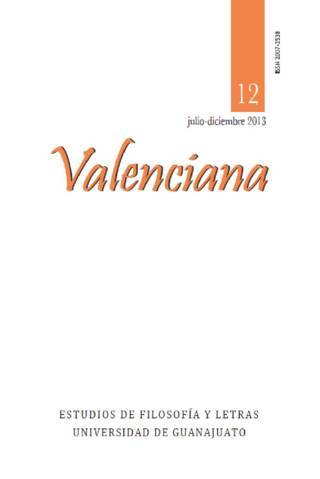Teoría del Nuevo Cine Latinoamericano: de la militancia al neobarroco
DOI:
https://doi.org/10.15174/rv.v0i12.8Keywords:
Nuevo Cine Latinoamericano, manifiestos, neobarroco, privado-social, Fernando Birri, Glauber Rocha, Jorge Sanjinés, Paul LeducAbstract
Este ensayo examina la transición de la militancia al neobarrocoen la teoría del Nuevo Cine Latinoamericano, a través de un análisis de manifiestos y películas de Fernando Birri, Glauber Rocha,
Jorge Sanjinés y Paul Leduc. El estudio concluye que el cambio
hacia una praxis neobarroca significó un giro hacia un proyecto
de izquierda más inclusivo y revolucionario ligado a lo que Aníbal
Quijano llama el privado-social.
References
Birri, Fernando, 1988, “Cine y subdesarrollo”, en Hojas de cine: Testimonios y documentos del Nuevo Cine Latinoamericano, vol. 1: Centro y Sudamérica, México, Secretaría de Educación Pública / Fundación Mexicana de Cineastas / Universidad Autónoma Metropolitana, pp. 17-22.
_____, 1996, Por un nuevo nuevo nuevo cine latinoamericano: 1956-1991, Madrid, Cátedra / Filmoteca Española.
_____, 1997, “For a Nationalist, Realist, Critical and Popular Cinema”, en Michael Martin (ed.), New Latin American Cinema, vol. 1: Theory, Practices, and Trasnacontinental Articulations, Detroit, Wayne State University Press, pp. 95-98.
Breton, André y Diego Rivera, 1979, “¡Por un arte revolucionario independiente!”, en Raquel Tibol (ed.), Arte y política, México, Grijalbo, pp. 181-186.
Celorio, Gonzalo, “Del barroco al neobarroco”, disponible en: http://www.jcortazar.udg.mx/sites/default/files/celorio.pdf, p. 23, (cosultado el 9/XII/13).
Chanan, Michael (ed.), 1983, Twenty Five Years of New Latin American Cinema, Londres, Channel Four Television.
Chiampi, Irlemar, 2001, Barroco y modernidad, México, Fondo de Cultura Económica.
Quijano, Aníbal, 1988, Modernidad, identidad y utopía en América Latina, Lima, Sociedad y Política Ediciones.
Herlinghaus, Hermann, 2011, “La película ORG (1969/1978) de Fernando Birri”, Revista de Crítica Literaria Latinoamericana, vol. 37, núm. 73, Lima y Boston, pp. 117-128.
Hojas de Cine, Testimonios y documentos del Nuevo Cine Latinoamericano, 3 vols., 1988, México, Secretaría de Educación Pública / Fundación Mexicana de Cineastas / Universidad Autónoma Metropolitana.
Martin, Michael (ed.), 1997, New Latin American Cinema, 2 vols., Detroit, Wayne State University Press.
Ruiz, Raúl, 2000, Poética del cine, Santiago de Chile, Sudamericana.
Rocha, Glauber, 1980, “Sinopse do Autor”, Tempo Glauber, disponible en: http://www.tempoglauber.com.br/glauber/Filmografia/idade.htm (consultado el 30/III/2013).
_____, 1997, “An Esthetic of Hunger”, en Michael Martin (ed.), New Latin American Cinema, vol. 1: Theory, Practices, and Trasncontinental Articulations, Detroit, Wayne State University Press, pp. 59-61.
_____, 2004, “Eztetyka do Sonho”, en Eduardo F. Costantini, Jr., Ana Goldman y Adrián Cangi (eds.), Glauber Rocha: Del hambre al sueño, Buenos Aires, Fundación Eduardo F. Costantini /MALBA, pp. 47-49.
Sanjinés, Jorge, 1988a, “Antecedentes históricos del cine social en Bolivia”, en Hojas de cine: Testimonios y documentos del Nuevo Cine Latinoamericano, vol. 1, México, Secretaría de Educación Pública / Fundación Mexicana de Cineastas / Universidad Autónoma Metropolitana, pp. 103-106.
_____, 1988b, “Problemas de la forma y del contenido en el cine revolucionario”, en Hojas de cine: Testimonios y documentos del Nuevo Cine Latinoamericano, vol. 1, México, Secretaría de Educación Pública / Fundación Mexicana de Cineastas / Universidad Autónoma Metropolitana, pp. 107-116.
_____, 1989, “El plano de secuencia integral”, Cine cubano, vol. 125, La Habana, pp. 65-71.
Sarduy, Severo, 1974, Barroco, Buenos Aires, Sudamericana.
Schroeder Rodríguez, Paul A., 2011, “La fase neobarroca del Nuevo Cine Latinoamericano”, Revista de Crítica Literaria Latinoamericana, vol. 37, núm. 73, Lima / Boston, pp. 15-36.
_____, [en prensa], “La primera vanguardia del cine latinoamericano” en Aurelio de los Reyes y David Wood (eds.), Actas del Coloquio Internacional Cine Mudo en Iberoamérica: Naciones, Narraciones, Centenarios, México, UNAM.
Published
How to Cite
Issue
Section
License
Author(s) who publish in this journal do accept the next conditions:
According to copyright regulations, Valenciana does recognize and respect the authors’ moral right, as well as the right of property, which will be assigned to the journal for its diffusion in open access.
Valenciana does not charge authors for the submission, editorial process or publication in the journal.
All texts published and distributed by Valenciana (without exception) are supported by the license Creative Commons Attribution-NonCommercial 4.0 International (CC BY-NC 4.0), which allows third parties to use the publication as long as they mention the author and the first publication.
Authors can make other independent and additional contractual agreements for the non-exclusive use of his article published in Valenciana (e.g. including it in an institutional repository or in printed/electronic media), as long as it is explicitly clarified that the article was published for the first time in this journal.
For these purposes, authors must sign and send the letter of submission and copyright transfer form in a PDF file to this email address: revistavalenciana@gmail.com
This journal is under a license by Creative Commons Atribución-NoComercial-SinDerivadas 4.0 Internacional (CC BY-NC-ND 4.0)).











